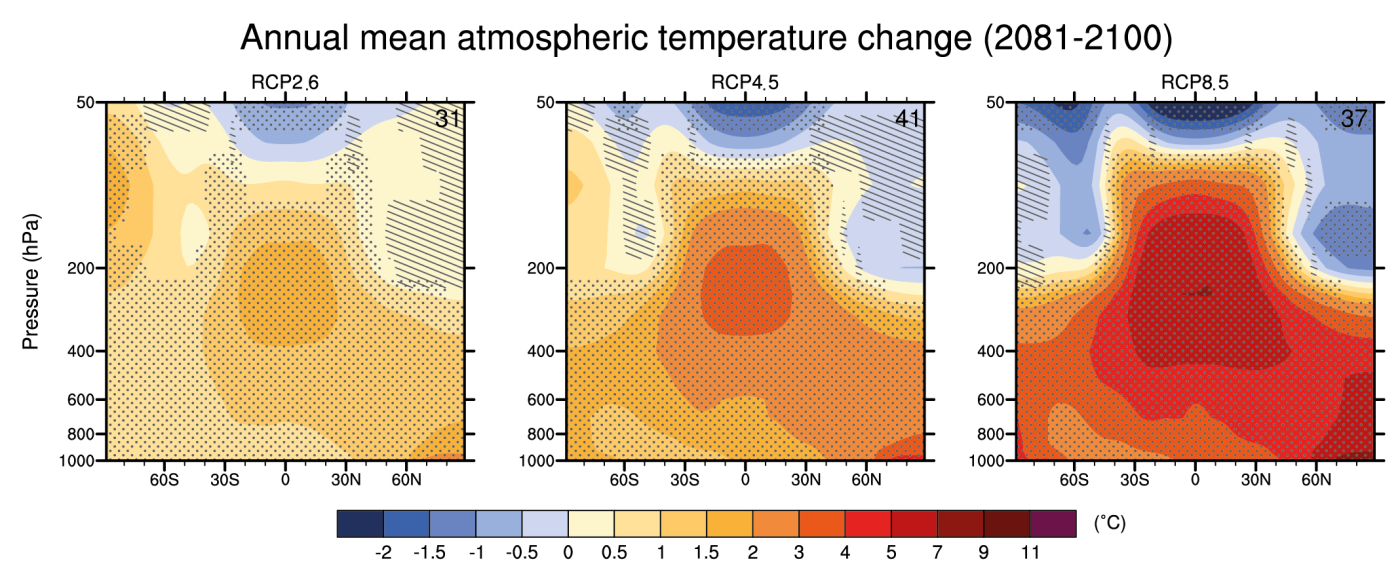According to model simulations with increasing carbon dioxide in the atmosphere, the zonal mean temperature in the atmosphere get warmer in the troposphere (< 10km or > 100hPa) and colder in the stratosphere (10 ~ 50km or 100 ~ 1hPa). A simple explanation is that the amount of infrared heat radiated out to the space by the increased CO2 is larger than the net amount of infrared heat received in the stratosphere from below and vice versa in the troposphere. In other words, increased CO2 in the troposphere retains larger amount of infrared heat coming from the surface, while increased CO2 in the stratosphere radiates larger amount of infrared heat out to the space. Planetary scientists point to Venus as an extreme example of the Earth in the future. The atmosphere of Venus is made up of 96.5% carbon dioxide with the average surface temperature of higher than 700°F (371°C). However, the upper atmosphere is much colder than that of the Earth because CO2 in the Vinus’ upper atmosphere radiates a large amount of infrared heat to the space.
A more scientific explanation can be found in the chapter 13 of Global Physical Climatology (by Hartmann). The energy balance in the stratosphere is mainly between heating through solar radiation by Ozone and cooling by infrared heat emission by CO2. The emission increases with increasing CO2. Therefore, the stratospheric temperature should decrease with increasing CO2.
Figure 12.12 from IPCC Report on Climate Change 2013 (The physical Science Basis): CMIP5 multi-model changes in annual mean zonal mean temperature in the atmosphere relative to 1986–2005 for 2081–2100 under the RCP2.6 (left), RCP4.5 (centre) and RCP8.5 (right) forcing scenarios. Hatching indicates regions where the multi-model mean change is less than one standard deviation of internal variability. Stippling indicates regions where the multi-model change mean is greater than two standard deviations of internal variability and where at least 90% of the models agree on the sign of change.
Laštovička, J., Akmaev, R. A., Beig, G., Bremer, J., & Emmert, J. T. (2006). Global change in the upper atmosphere. Science, 314(5803), 1253-1254. http://science.sciencemag.org/content/314/5803/1253
IPCC, 2013: Climate Change 2013: The Physical Science Basis. Contribution of Working Group I to the Fifth Assessment Report of the Intergovernmental Panel on Climate Change [Stocker, T.F., D. Qin, G.-K. Plattner, M. Tignor, S.K. Allen, J. Boschung, A. Nauels, Y. Xia, V. Bex and P.M. Midgley (eds.)]. Cambridge University Press, Cambridge, United Kingdom and New York, NY, USA, 1535 pp, doi:10.1017/CBO9781107415324.


I would like to thank Dongmin, Amy, Hosmay, Soumi and Brian for helping me to better understand this atmospheric radiation balance.
An alternative explanation is provided by Lin and Emanuel (2024).
Lin, J., & Emanuel, K. 2024: Why the lower stratosphere cools when the troposphere warms. Proceedings of the National Academy of Sciences 121(11), e2319228121.